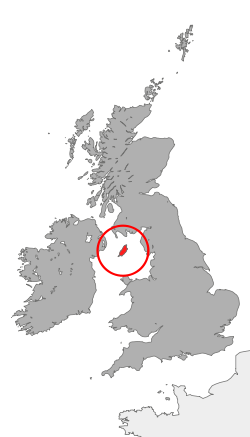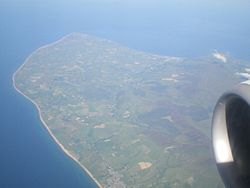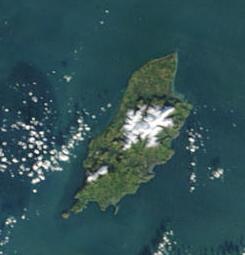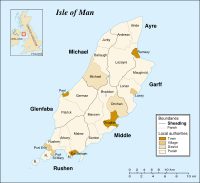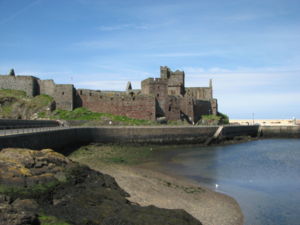Isle of Man
2008/9 Schools Wikipedia Selection. Related subjects: Geography of Great Britain
| Ellan Vannin Isle of Man
|
||||||
|---|---|---|---|---|---|---|
|
||||||
| Motto: Quocunque Jeceris Stabit (Latin) Whithersoever you throw it, it will stand |
||||||
| Anthem: " O Land of Our Birth" "Arrane Ashoonagh dy Vannin" ( Manx) Royal anthem: " God Save the Queen" |
||||||
|
Location of Isle of Man (red)
|
||||||
| Capital (and largest city) |
Douglas (Doolish) |
|||||
| Official languages | Manx, English | |||||
| Demonym | Manx | |||||
| Government | Crown dependency (UK) Parliamentary democracy (Constitutional monarchy) | |||||
| - | Lord of Mann | Elizabeth II | ||||
| - | Lieutenant Governor | Sir Paul Haddacks | ||||
| - | First Deemster | Michael Kerruish | ||||
| - | President of Tynwald | Noel Cringle | ||||
| - | Chief Minister | Tony Brown | ||||
| Status | Crown dependency | |||||
| - | Revested in British crown | 1765 | ||||
| Area | ||||||
| - | Total | 572 km² ( 191st) 221 sq mi |
||||
| - | Water (%) | 0 | ||||
| Population | ||||||
| - | estimate | 80,058 ( 194st) | ||||
| - | Density | 131.2/km² ( 75th) 339.6/sq mi |
||||
| GDP ( PPP) | 2003 estimate | |||||
| - | Total | $2.113 billion ( 182nd) | ||||
| - | Per capita | $35,000 ( 11/12th) | ||||
| HDI (n/a) | n/a (unranked) ( n/a) | |||||
| Currency | Pound sterling1 ( GBP) |
|||||
| Time zone | GMT ( UTC+0) | |||||
| - | Summer ( DST) | ( UTC+1) | ||||
| Internet TLD | .im | |||||
| Calling code | +44 (UK area code 01624) | |||||
| 1 | The Isle of Man Treasury issues its own sterling notes and coins (see Manx pound). | |||||
The Isle of Man ( Manx: Ellan Vannin, pronounced [ˈɛlʲən ˈvanɪn]) or Mann ( Manx: Mannin, [ˈmanɪn]) is a self-governing Crown dependency, located in the Irish Sea at the geographical centre of the British Isles. The head of state is Queen Elizabeth II, who holds the title of Lord of Mann. The Crown is represented by a Lieutenant Governor. The island is not part of the United Kingdom, but foreign relations, defence, and ultimate good-governance of the Isle of Man are the responsibility of the government of the United Kingdom.
The island was a Celtic community which came under the rule of the Norse in 1079. This has left a legacy from the Tynwald government to many place names. After a period of alternating rule by the Kings of England and Scotland, the Manx came under the feudal over-lordship of the English Crown. The lordship revested to the British Crown in 1764 but the island never became part of the United Kingdom. This accounts for its current position as a Crown dependency.
The Isle of Man is not a part of the European Union, but because of Protocol 3 of the Treaty of Accession in 1972, there does exist the free movement of goods between the two entities.
History
Ancient times to present
The earliest traces of people on the Isle of Man can be found as far back as the Mesolithic Period, also known as the Middle Stone Age. The first residents lived in small natural shelters, hunting, fishing and gathering for their food. They used small tools made of flint or bone, which have been found near the coast. Representatives of these artifacts are kept at the Manx Museum.
The Neolithic Period marked the coming of knowledge of farming, better stone tools and pottery. It was during this period that Megalithic Monuments began to appear around the island. Examples from this period can be found at Cashtal yn Ard near Maughold, King Orry's Grave in Laxey, Meayll Circle near Cregneash, and Ballaharra Stones in St Johns. The Megaliths were not the only culture during this time, there were also the local Ronaldsway and Bann cultures.
During the Bronze Age, the large communal tombs of the Megaliths were replaced with smaller burial mounds. Bodies were put in stone lined graves along with ornamental containers. The Bronze Age burial mounds created long lasting markers about the countryside.
The Iron Age marked the beginning of Celtic cultural influence. Large hill forts appeared on hill summits, and smaller promontory forts along the coastal cliffs, while large timber-framed roundhouses were built. It is likely that the first Celtic tribes to inhabit the Island were of the Brythonic variety. Around AD 700 it is assumed that Irish invasion or immigration formed the basis of the early Manx population. This is evident in the change in language used in Ogham inscriptions. Manx Gaelic remains closely related to Irish and Scots Gaelic.
Viking settlement on the Isle of Man began at the end of the eighth century. Though the Vikings established Tynwald and introduced many land divisions that still exist, they had little actual influence on the culture of the Manx people. Although the Manx language does contain Norse influences, they are few. The Norse Kingdom of Mann and the Isles was created by Godred Crovan in 1079 after the Battle of Skyhill. During Viking times, the islands of this kingdom were called the Súðreyjar or Sudreys ("southern isles") in contrast to the Norðreyjar ("northern isles") of Orkney and Shetland. This later became anglacized as Sodor. The Church of England diocese is still called the Diocese of Sodor and Man although it only covers Mann. (When the Rev. W. V. Awdry wrote The Railway Series, he invented the island of Sodor as an imaginary island located between the Isle of Man and the Cumbrian coast.)
In 1266, as dictated in the Treaty of Perth, Norway's King Magnus VI ceded the isles to Scotland. The Isle of Man came under English control in the fourteenth century. During this period the Isle was dominated by the Stanley family, who also held the title of Earl of Derby, who had been given possession of Man by King Henry IV. In 1703 the Act of Settlement secured peasant rights and marked the beginning of a move away from feudal government. In 1765, however, the British crown secured a greater control over the island, (called "the Revestment") without incorporating it into the United Kingdom, laying the grounds for the island's status as a Crown dependency.
In 1866 greater autonomy was restored to the island's parliament and a full transition to democracy began. The Isle quickly developed as a tax haven and tourist centre, becoming increasingly prosperous during the Twentieth century. During both the First and Second World Wars the island was used as a location for internment camps for axis citizens and suspected sympathisers.
Tynwald
Tynwald, the Island's parliament, was nominally founded in AD 979. It is arguably the oldest continuous parliament in the world. The annual ceremonial meeting in July on Tynwald Day, the Island's national day, continues to be held at Tynwald Hill, where titles are announced and a brief description of the new laws enacted by Tynwald during the previous year is given.
Geography
As well as the main island of Man itself, the Isle of Man includes some nearby small islands: the partially inhabited Calf of Man, and the uninhabited Chicken Rock and St. Patrick's Isle.
The Isle of Man is located geographically in the middle of the northern Irish Sea, close to the geographical centre of the British Isles, an archipelago off the north-western coast of mainland Europe. The island lies closest to Scotland followed by England, Ireland and Wales.
Approximately 32 miles (51 km) long and between 8 miles (13 km) and 15 miles (24 km) wide, the island has an area of around 221 square miles (570 km²).
Hills in the north and south are bisected by a central valley. The extreme north is exceptionally flat, consisting mainly of deposits built up by deposition from glacial advances from Western Scotland during colder times. There are more recently deposited shingle beaches at the Point of Ayre. It has only one mountain higher than 2,000 feet (610 m), Snaefell, with a height of 2,036 feet (621 m). According to an old saying, from the summit one can see six kingdoms: those of Mann, Scotland, England, Ireland, Wales, and Heaven. Some versions add a seventh kingdom, that of Neptune or the Sea.
Population
According to the 2006 interim census, the Isle of Man is home to 80,058 people, of whom 26,218 reside in the island's capital Douglas. Most of the population were born in the British Isles, with 47.6% born in the Isle of Man, 37.2% born in England, 3.4% in Scotland, 2.1% in Northern Ireland, 2.1% in the Republic of Ireland, 1.2% in Wales and 0.3% born in the Channel Islands.
Government
The United Kingdom is responsible for the Island's defence and ultimately for good governance, and for representing the Island in international forums, while the Island's own parliament and government have competence over all domestic matters.
Structure
The Island's parliament is Tynwald, which dates from at least AD 979 and is said to be the oldest continuously existing parliament in the world. Tynwald is a bicameral legislature, comprising the House of Keys (directly elected by universal suffrage) and the Legislative Council (consisting of indirectly elected and ex-officio members). These two bodies meet together in joint session as Tynwald.
The executive branch of government is the Council of Ministers, which is composed of members of Tynwald. It is headed by the Chief Minister, currently Tony Brown MHK.
Vice-regal functions of the Head of State are performed by a Lieutenant Governor.
External relations
Under British law, the Isle of Man is not part of the United Kingdom. However, the UK takes care of its external and defence affairs, and retains paramount power to legislate for the Island.
Citizenship
Citizenship is covered by UK law, and Manx people are classed as British citizens, although those without a grandparent born in the UK (or who have not lived continuously for a period of five or more years in the UK) do not have the same rights as other British citizens with regard to employment and establishment in the European Union.
European Union
The Isle of Man holds neither membership nor associate membership of the European Union. Protocol Three of the treaty of accession of the United Kingdom permits trade for Manx goods without tariffs. In conjunction with the Customs and Excise agreement with the UK, this facilitates free trade with the UK. While Manx goods can be freely moved within the EU, people, capital and services cannot. EU citizens are entitled to travel and reside in the Island without restriction.
Commonwealth of Nations
The Isle of Man is not itself a member of the Commonwealth of Nations. By virtue of its relationship with the United Kingdom, it takes part in several Commonwealth institutions, including the Commonwealth Parliamentary Association and the Commonwealth Games.
Politics
Most Manx politicians stand for election as independents rather than as representatives of political parties. Though political parties do exist, their influence is not nearly as strong as is the case in the United Kingdom.
The largest political party is the recently established Liberal Vannin Party, which promotes greater Manx independence and more accountability in Government. The LibVannin party has two members of Tynwald including Leader Peter Karran MHK.
A nationalist pressure group Mec Vannin advocates the establishment of a sovereign republic.
Local government
Local government on the Isle of Man is based around the concept of ancient parishes. There are three types of local authorities: a borough corporation, town commissions, and parish commissions.
Census in the Isle of Man
The Isle of Man Full Census, most recently held in 2001, has been a ten yearly occurrence since 1821, with interim censuses being introduced from 1966. As a British Crown dependency, it is separate, but closely related to the Census in the United Kingdom.
The 2001 Census was conducted by the Economic Affairs Division of the Isle of Man Treasury, under the authority of the Census Act 1929.
Economy
The Isle of Man is a 'so-called' low tax economy with no capital gains tax, wealth tax, stamp duty or inheritance tax and a top rate of income tax of 18%. A "tax cap" is in force. The maximum amount of tax payable by an individual is £100,000 or £200,000 for couples if they choose to have their incomes jointly assessed. The £100,000 tax cap equates to an assessable income of approximately £570,000. Personal income is assessed and taxed on a total 'worldwide' income basis rather than a remittance basis. This means that all income earned throughout the world is assessable for Manx tax rather than only income earned in or brought into the IoM. It is therefore important for individuals to calculate whether Manx tax treatment is actually more favourable than that in remittance based legislatures such as Ireland. Residency rules, 60 days per annum, are lower than those in surrounding states.
The rate of corporation tax is 0% for almost all types of income, the only exceptions are that the profits of banks are taxed at 10%, as is rental (or other) income from land and buildings situated on the Isle of Man.
Offshore banking, manufacturing, and tourism form key sectors of the economy. Agriculture and fishing, once the mainstays of the economy, now make declining contributions to the Island's Gross Domestic Product (GDP).
Trade takes place mostly with the United Kingdom.
The Manx government promotes island locations for making films by contributing to the production costs. Since 1995 over 80 films have been made on the Island.
Communications
The main telephone provider on the Isle of Man is Manx Telecom. The island has two mobile operators Manx Pronto (provided by Manx Telecom) and Sure Mobile (provided by Cable & Wireless). Broadband internet services are available through four local providers which are Domicilium, Manx Computer Bureau, Wi-Manx and Manx Telecom. The Island does not have its own ITU country code, but is accessed via the UK's code (+44) and the Island's telephone numbers are part of the UK telephone numbering plan with local dialling codes 01624 (landlines) and 07624/07924 (mobiles).
In December 2007, the Manx Electricity Authority and its telecoms subsidiary, e-llan Communications Limited, commissioned the lighting of a new fibre-optic link that connects the Island to a worldwide fibre optic network.
The Isle of Man has three radio stations: Manx Radio, Energy FM, and 3 FM.
There is no domestic television service, and local transmitters retransmit analogue broadcasts of BBC 1 and BBC 2 (with BBC North West regional programmes), ITV Border Television and Channel 4. Five is not available via the Island's analogue transmitters.
Many TV services are available by satellite, such as Sky Digital, and Freesat from the Astra 2/Eurobird 1 group, as well as services from a range of other satellites around Europe such as Astra 1 and Hotbird.
In some areas, terrestrial television (including digital terrestrial) from the United Kingdom (Freeview) or Republic of Ireland can be received.
Analogue television transmission will cease between 2008 and 2009, and limited local transmission of digital terrestrial television will then commence.
Transport
The island has a total of 688 miles (1,107 km) of public roads, all of which are paved. Many of the roads on the island have no speed limit, although measured travel speeds are often relatively low.
| Isle of Man Travel Speeds | ||||
| Speed Limit | 85% Speed | 85% Speed | ||
| Measurement Site | (mph) | Eastbound (mph) | Westbound (mph) | Measurement Dates |
| Ballafreer House, Main Road, Marown | No Limit | 46 | 47 | 27 June – 4 July 2005 |
| Main Road, Baldrine | 30 | 36 | 36 | 21 November – 28 November 2005 |
| Glen Mona, Maughold (parish) | Derestricted | 38 | 42 | 26 September – 3 October 2005 |
| Ballamodha Straight, Malew | 40 | 51 | 50 | 6 March – 13 March 2006 |
| Ballacobb, Ballaugh | No Limit | 51 | 40 | 3 July – 10 July 2006 |
| Richmond Hill, Douglas (By bus stop) | 50 | 55 | 50 | 24 April – 1 May 2006 |
| Shore Road, Outside Limekilns Farm | No Limit | 49 | 50 | 2 August – 8 August 2004 |
| Windy Corner, Onchan | No Limit | 54 | 57 | 17 July – 24 July 2006 |
source: Transport Implications of the Isle of Man Strategic Plan
Douglas is served by frequent ferries to and from England and more limited summer-only services from Ireland. All ferries are operated by the Isle of Man Steam Packet Company.
The only commercial airport on the island is the Isle of Man Airport at Ronaldsway.
The island used to have an extensive narrow-gauge railway system, both steam-operated and electric, but the majority of the steam railway tracks have been taken out of service and the track removed. Currently there is a steam railway which runs between Douglas and Port Erin, an electric railway which runs between Douglas and Ramsey and an electric mountain railway which climbs Snaefell. The lines are mostly operated for the benefit of tourists, though some people use them for commuting.
The Island-wide bus network is operated by Isle of Man Transport. Both Single- and Double-decker buses are in service.
Culture
The culture of the Isle of Man is influenced by its Norse and Celtic cultural origins, though its close proximity to the UK, period as a UK tourist destination and recent mass immigration by British migrant workers has meant that British influence has been dominant since the Revestment period. Recent revival campaigns have attempted to preserve the surviving vestiges of Manx culture after a long period of Anglicization, and significant interest in the Manx language, history and musical tradition have been the result.
Etymology of name
The origin of the name Isle of Man is unclear. In the Manx Gaelic language the Isle of Man is known as Ellan Vannin, where ellan is a Gaelic word meaning 'island'. The earliest form of 'Man' is Manu or Mana giving the genitive name Manann leading to the word Mannin, to which a 'h' is added when used after the feminine word Ellan, giving Mhannin. As 'mh' is pronounced like a 'v' in Goidelic languages, in modern Manx the name becomes Ellan Vannin.
During the period of Julius Caesar as proconsul and his visit to Britain during 55 and 54 BC Caesar referred to the Isle of Man in his Commentarii de Bello Gallico to 'an island called Mona which lies midway across the sea separating Britain from Ireland.'
Language
The official languages of the Isle of Man are Manx Gaelic and English. A dialect of English known as Manx English is spoken.
The Manx Gaelic language is a Goidelic Celtic language and is one of a number of insular Celtic languages spoken in the British Isles. Manx Gaelic has been officially recognised as a legitimate autochthonous regional language under the European Charter for Regional or Minority Languages, ratified by the United Kingdom on 27 March 2001 on behalf of the Isle of Man government.
The Manx language is closely related to the Irish language and Scottish Gaelic. By the middle of the twentieth century only a few elderly native speakers remained: the last of them, Ned Maddrell, died on December 27, 1974. By then a scholarly revival had begun to spread to the populace and many had learned Manx as a second language. The first native speakers of Manx (bilingual with English) in many years have now appeared: children brought up by Manx-speaking parents. Primary immersion education in Manx is provided by the Manx government: since 2003, the former St John's School building has been used by the Bunscoill Gaelgagh (Manx language-medium school). Degrees in Manx are available from the Isle of Man College and the Centre for Manx Studies. Manx-language playgroups also exist, and Manx language classes are available in island schools. In the 2001 census, 1,689 out of 76,315, or 2.2% of the population, claimed to have knowledge of Manx, although the degree of knowledge in these cases was presumably varied.
In common use are the greetings moghrey mie and fastyr mie which mean 'good morning' and 'good afternoon' respectively. The Manx language knows no 'evening' as it is 'afternoon'. Another frequently heard Manx expression is traa dy liooar meaning 'time enough', and represents a stereotypical view of the Manx attitude to life.
Symbols
For centuries, the Island's symbol has been its ancient triskelion, a device similar to Sicily's Trinacria: three bent legs, each with a spur, joined at the thigh. The Manx triskelion does not appear to have an official definition; Government publications, currency, flags, the tourist authority and others all use different variants. Most, but not all, preserve rotational symmetry, some running clockwise, others counter-clockwise. Some have the uppermost thigh at 12:00, others at 11:30 or 10:00, etc. Some have the knee bent at 90°, some at 60°, some at closer to 120°. Also the degree of ornamentation of the leg wear and spur vary considerably.
The three legs relate directly to the island's motto (adopted late in the symbol's history): Quocunque Jeceris Stabit, translated as 'Whithersoever you throw it, it will stand'. Interpretations of the motto often stress stability and robustness in the Manx character. Many schools on the island have adapted the motto to promote perseverance and hard work.
The origin of the 'Three Legs of Man' (as they are usually called) is explained in the Manx legend that Manannan repelled an invasion by transforming into the three legs and rolling down the hill and defeating the invaders.
Variations on the Manx triskelion are still in use on the coats of arms belonging to the different branches of the ancient Norwegian noble family that ruled Mann until the thirteenth century. This particular version belongs to the Skancke branch of the Skanke family. The name stems from skank, the Norwegian version of the word 'shank', or ' leg'. The Norse royal family of Man stayed on the island for some years after the death of Magnus III and the beginning of Scottish rule. The family's emigration only came after the a final attempt on the part of the Manx at restoring the old Sudreyar dynasty in the 1275 uprising against the Scots. This revolt failed disastrously, ending in the deaths of hundreds of rebels, including the last Norse King of Mann, Godred VI Magnuson when the Manx suffered defeat in the decisive Battle of Ronaldsway, near Castletown. When the Norse-Manx royals arrived in Norway they took service as nobles of the Norwegian king, quickly becoming knights, landlords, and clergy under the Norwegian Crown.
Myth, legend and folklore
In Manx mythology, the island was ruled by Manannán mac Lir, a Celtic sea god, who would draw his misty cloak around the island to protect it from invaders. One of the principal theories about the origin of the name Mann is that it is named after Manannan.
In the Manx tradition of folklore, there are many stories of mythical creatures and characters. These include the Buggane, a malevolent spirit who according to legend blew the roof off St Trinian's church in a fit of pique; the Fenodyree; the Glashtyn; and the Moddey Dhoo, a ghostly black dog who wandered the walls and corridors of Peel Castle.
The Isle of Man is also said to be home to fairies, known locally as 'the little folk' or 'themselves'. There is a famous Fairy Bridge and it is said to be bad luck if one fails to wish the fairies good morning or afternoon when passing over it. It used to be a tradition to leave a coin on the bridge to ensure good luck. Other types of fairies are the Mi'raj and the Arkan Sonney.
An old Irish story tells how Lough Neagh was formed when Ireland's legendary giant Fionn mac Cumhaill (sometimes known as Finn McCool) scooped up a portion of the land and tossed it at a Scottish rival. He missed, and the chunk of earth landed in the Irish Sea, thus creating the island.
Cuisine
Traditionally the national dish of the Island is 'Spuds and Herrin', boiled potatoes and herring. This plain dish is chosen because of its role supporting the subsistence farmers of the island, who crofted the land and fished the sea for centuries.
A more recent claim for the title of national dish would be the ubiquitous chips, cheese and gravy, which is similar to the Canadian dish of poutine. Known locally as "CCG", it is found in most of the Island's fast-food outlets, and consists of thick cut chips, covered in shredded Manx cheddar cheese and topped with a thick gravy.
Seafood has traditionally accounted for a large proportion of the local diet. Although commercial fishing has declined in recent years, local delicacies include Manx kippers (smoked herring) which are produced by the smokeries in Peel on the west coast of the island, albeit mainly from North Sea herring these days. The smokeries also produce other specialities including smoked salmon and bacon.
Crab, lobster and scallops are commercially fished, and the Queen Scallop ('Queenies') is regarded as a particular delicacy, with a light, sweet flavour. Cod, ling and mackerel are often angled for the table, and freshwater trout and salmon can be taken from the local rivers and lakes, supported by the Government fish hatchery at Cornaa.
Cattle, sheep, pigs and poultry are all commercially farmed, Manx lamb from the hill-farms being a popular dish. The Loaghtan, the indigenous breed of Manx sheep, has a rich, dark meat that has found favour with chefs, featuring in dishes on the BBC's Masterchef series.
Milk and cheese are produced by IOM Creameries. Manx cheese has been a particular success, featuring smoked and herb-flavoured varieties, and is stocked by many of the UK's supermarket chains. Manx cheese took bronze medals in the 2005 British Cheese Awards, and sold 578 tonnes over the year.
Beer is brewed on a commercial scale by Okells Brewery (established in 1850) and Bushy's Brewery.
Sport
The Isle of Man is represented as a nation in the Commonwealth Games and the Island Games and will be hosting the IV Commonwealth Youth Games in 2011. The Island started the Island Games in 1985, and also hosted the Island Games in 2001.
Isle of Man teams and individuals participate in many sports both on and off the island including rugby union, football, gymnastics, hockey, bowling and cricket. Being an island, many types of watersports are also popular with residents.
Mark Cavendish, a pro cyclist riding for Team Columbia, was the first Manx to win a stage of the Tour de France on 09 July 2008. He then went on to win three additional stages, becoming the first Briton to win four stages (5, 8, 12, 13) of the same Tour.
Motorcycle racing
The main international motorcycle event associated with the island is the Isle of Man TT, which began in 1907 and takes place in late May and early June. It is now an international road racing event for motor bikes and used to be part of the World Championship. The Manx Grand Prix is a motorcycle event for amateurs and private entrants that uses the same 37.73 miles (60.72 km) Snaefell Mountain Course in late August and early September.
Cammag
Cammag is the national sport of the Isle of Man. It is similar to the Scottish game of shinty, and Irish hurling. Once the most popular sport on the Island, it ceased to be played by the start of the 20th century. It has more recently been revived with an annual match at St John's.
Famous residents
Born or raised on the island
- The Bee Gees
- Mark Cavendish, sprint cyclist.
- Charles Kerruish became in 1961 the first Manxman to be head of government.
- Illiam Dhone led an uprising against English rule over the island and was executed in 1663.
- Nigel Kneale, seminal science fiction and horror screenwriter.
- Myles Standish, Captain of the Mayflower, believed to be born in Ellan Bane Farm, Lezayre, but some evidence has also located his birth place as Duxbury in England.
Moved to the island
- James Toseland, the current World Superbike Champion and MotoGP Rider
- Neil Hodgson, the 2003 Superbike and World Superbike Champion.
- George MacDonald Fraser, author
- Sir Norman Wisdom, comedian and actor.
- John Rhys Davies, actor.
- Andy Kershaw, DJ.
- Jeremy Clarkson, the journalist and broadcaster has a second home on the island.
- Nigel Mansell, 1992 Formula One and 1993 Indy Car World Champion
- Steve Hislop, former motorcycle world champion.


